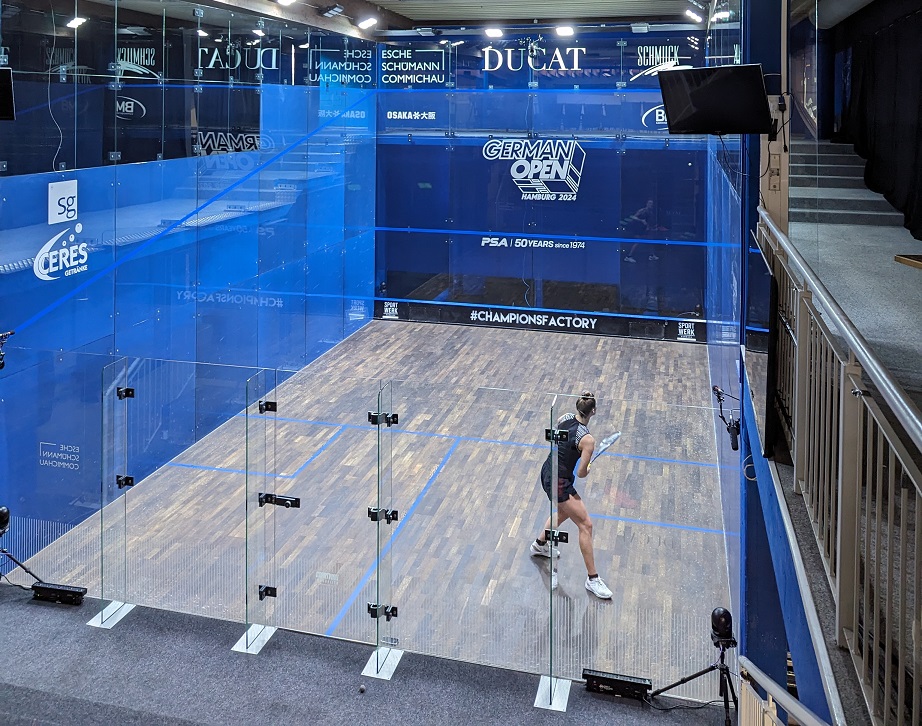
4G and 5G networks are now capable of providing high-speed connectivity even in remote locations. This has revolutionised areas such as newsgathering where it is now routine to deliver news feeds over cellular. But the use of 5G has not extended widely to sports transmissions, aside from feeds such as press conferences, interviews or web streaming. Why is this the case even when 4G/5G data rates are high enough for professional sports?
Our recent work with the Professional Squash Association delivering the German Open 2024 and subsequently other events over 5G highlights well many of the challenges (and naturally how we can solve them).
Indoor environment
While many sports are played outdoors, making them ideal for using 5G, often the broadcast centre is indoors, meaning that 5G signals are often weak or nonexistent. Even a simple window can be the difference between 1Mbit and 10Mbit per second. Most cellular bonding equipment have tiny antennas, which do not help in low-signal environments.
The German Open was a particularly difficult case because the broadcast centre was in a squash court, essentially a building inside a building, making the 5G signal weak. We solved this in our 5G Flyaway solution by using Power-over-Ethernet (PoE) routers with powerful inbuilt antennas. These routers were placed on the roof up to 100m (300ft) away from the broadcast centre, meaning the signal was much stronger.
External routers are also valuable for outdoor events because they can be placed high up and reach more cell towers, ideally with no obstructions in the way.
Congested Networks
Another challenge during sporting events is that there are lots of spectators using data on their mobile phones, reducing network speeds. External routers placed high up also help mitigate these effects, as they can reach towers at a distance that mobile phones cannot. Again, the more powerful antennas mean we can obtain the maximum signal strength.
What’s interesting to note, however, is that many vendors deal with network fluctuations by reacting too aggressively to network changes with Adaptive Bitrate (ABR). This means the picture quality will decrease temporarily, or even change in resolution. But fluctuations in picture quality are not acceptable in television-based sports. The good news is that network fluctuation is transient and in most cases, you can happily maintain constant-bitrate (CBR), so ABR is not even necessary (despite claims to the contrary).
 This picture shows a football match being transmitted from a remote location in Croatia. It shows a high average packet loss rate, around 2%, (all packets were of course recovered). But it’s an average and the chances are there were much larger peaks of packet loss. Adaptive bitrate products would have cut the bitrate drastically during these peaks as they would have believed this loss to be “congestion”, even if that packet loss was recoverable. To put it simply: Adaptive bitrate products treat minor network fluctuations as being much more serious. Changes in picture quality would have been unacceptable for a TV broadcast.
This picture shows a football match being transmitted from a remote location in Croatia. It shows a high average packet loss rate, around 2%, (all packets were of course recovered). But it’s an average and the chances are there were much larger peaks of packet loss. Adaptive bitrate products would have cut the bitrate drastically during these peaks as they would have believed this loss to be “congestion”, even if that packet loss was recoverable. To put it simply: Adaptive bitrate products treat minor network fluctuations as being much more serious. Changes in picture quality would have been unacceptable for a TV broadcast.
The picture shows that Zixi (part of our 5G Flyaway solution) was able to maintain a strict CBR stream throughout the transient packet loss.
Strict Compliance
The signal being transmitted in sports often goes through various stages in the workflow: from on-pass to satellite uplink or cloud workflow. This means, unlike news feeds, it’s vital that the stream is compatible with all the equipment downstream. Otherwise, the feed requires a re-encode to maintain compatibility, adding latency and reducing picture quality.
Virtually all sports broadcasters send their content to many different recipients around the world, known as “takers”. Each taker will have its own receiver device. And it might not even be possible to test each single receiver before the event. That’s why interoperability with third-party receivers is paramount, to ensure that each receiver will be able to decode the streams it receives. Such interoperability can only be achieved through strict compliance with standards, which is what the takers expect.
Our 5G Flyaway solution ensures interoperability by delivering a non-proprietary Constant Bitrate Transport Stream that can be decoded by any decoder (whereas ABR-based streams would work only with a particular vendor’s decoder), bringing peace of mind to both content provider and takers.
The diagram below compares the MPEG-Transport Stream bitrate for our OBE C-100 Encoder with that of a popular cellular bonded backpack.

While this looks like the effect of ABR, this measurement was taken over a LAN, and actually shows the encoder not being able to produce a valid CBR stream. Many professional receivers would not be able to decode such a stream.
 Likewise, this second cellular bonded backpack produces a very high jitter on its output, again something professional receivers will not tolerate.
Likewise, this second cellular bonded backpack produces a very high jitter on its output, again something professional receivers will not tolerate.
In both cases, a vendor-specific decoder is needed and the feed would need to be re-encoded for delivery to takers.
Read more about this here: https://www.obe.tv/strict-cbr-and-dvb-compliant-video-over-4g-and-5g-bonded-networks.
5G Use cases for live sports contribution
5G can be an extremely useful tool for two use cases:
1) Replacing satellite backup
In many sports, events travel around the world. If team A wins against team B, the next match will be at team A’s venue – and often within just a matter of days. Moreover, there can be last-minute changes to the event start time, even after the broadcaster has booked the satellite. This means the broadcaster needs to handle event changes at very short notice. Global connectivity is important.
While satellite is often seen as a great back-up to ensure connectivity, the need for satellite space bookings and vehicle rental can mean the process is not agile enough, especially for sports that transmit for long hours over many days. By combining 5G with Starlink, you can get an independent transmission path that gets rid of the clunky satellite processes.
2) Covering lower-budget sports events on television
Television broadcasts of sports events coverage demand high picture quality with strict compliance to standards (in contrast to streams on YouTube for example). Traditionally this would usually come with huge costs attached. But not all sports have such budgets, which means that for some sports, meeting these demands is a challenge.
By offering a cost-effective alternative, our 5G Flyaway enables events to be covered that would otherwise be uneconomical to cover – while delivering to TV stations that expect strict interoperability and high picture quality. Sports such as Women’s UEFA Football or Under 21s can then reach wider audiences on linear television.
How 5G Flyaway saved the day
5G Flyaway saved the day at the Professional Squash Association by offering a simple solution that provided peace of mind when on-site connectivity failed. It was preconfigured to start up without any user intervention, saving time for busy production staff on the ground. It handles event changes at short notice and, importantly, runs with a global SIM card, meaning there is no need to change SIM card in each country.
This last point is crucial for peace of mind. SIMs are small and easily lost, and the logistics of having to buy multiple SIM cards for different countries can be a nightmare: the queues at the phone shop in each country; the ambiguity around whether your data plan is actually “Unlimited” (the small print might say otherwise). Having a global SIM card does away with all that.
5G: Looking to the future
While challenges exist when using 5G for sports broadcasting, these challenges have be overcome.
Overall, 5G has huge potential to enhance the video contribution of live sports events by providing higher bandwidth, lower latency, and improved reliability. Using 5G with the right contribution encoders and decoders offers a more flexible production experience, allowing production staff to focus on producing more and better content.
Learn more about our 5G Flyaway: https://www.obe.tv/5g-flyaway/

